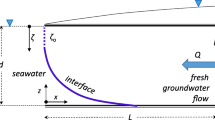Abstract
We consider a model mixing sharp and diffuse interface approaches for seawater intrusion phenomenon in confined aquifers. The problem consists of a strongly coupled system of partial differential equations of parabolic and elliptic types. The aim of this work is to introduce and analyze a new mixed formulation, obtained by writing the system into a matrix form and introducing a new variable σ = R(u)∇u, representing the flux tensor of the primal variable u = (h,Φf)T. Here, h stands for the depth of salt/freshwater interface, Φf, the hydraulic head of fresh water, and R(u) a symmetric and positive definite diffusion matrix. We show that the continuous problem as well as its mixed finite element approximation are well posed. We also provide optimal error estimates in L2 −norm for both variables u and its associated flux σ.

Similar content being viewed by others
References
Abudawia, A., Rosier, C.: Numerical analysis for a seawater intrusion problem in a confined aquifer. Math. Comput. Simul. 118, 2–16 (2015)
Ambartsumyan, I., Khattatov, E., Yotov, I.: A coupled multipoint stress–multipoint flux mixed finite element method for the biot system of poroelasticity. Comput. Methods Appl. Mech. Eng. 372(113), 407 (2020)
Bear, J.: Dynamics Of Fluids in Porous Media. American Elsevier, New York (1972)
Boffi, D., Brezzi, F., Fortin, M.: Mixed Finite Element Methods and Applications. Springer, Berlin (2013)
Brezzi, F., Fortin, M.: Mixed and Hybrid Finite Element Methods. Springer, Berlin (1991)
Chavent, G., Roberts, J. E.: A unified physical presentation of mixed, mixed-hybrid finite elements and standard finite difference approximations for the determination of velocities in waterflow problems. Adv. Water Resour. 14, 329–348 (1991)
Choquet, C., Li, J., Rosier, C.: Global existence for seawater intrusion models: comparison between sharp interface and sharp-diffuse interface approaches. Electron. J. Differ. Equ. 2015(126), 1–27 (2015)
Choquet, C., Diedhiou, M., Rosier, C.: Derivation of a sharp-diffuse interfaces model for seawater intrusion in a free aquifer. numerical simulations. Math. Comput. Simul. 76, 138–158 (2016)
Choquet, C., Li, J., Rosier, C.: Uniqueness for cross-diffusion systems issuing from seawater intrusion problems. Electron. J. Differ. Equ. 2017(256), 1–22 (2017)
Ciarlet, P.: The Finite Element Methods for Elliptic Problem (1978)
Durlofsky, L. J.: Accuracy of mixed and control volume finite element approximations to Darcy velocity and related quantities. Water Resour. Res. 30, 965–973 (1994)
Farhloul, M.: Mixed finite element methods for the Oseen problem. Numer. Algorithms 84, 1431–1442 (2020)
Farhloul, M., Zine, A.: A dual-mixed finite element method for quasi-newtonian flows whose viscosity obeys a power law or the carreau law. Math. Comput. Simul. 141, 83–95 (2017)
Farhloul, M., Nicaise, S., Paquet, L.: A refined mixed finite element method for the boussinesq equations in polygonal domains. IMA J. Numer. Anal. 21, 525–551 (2001)
Girault, V., Raviart, P.: Finite Element Methods for Navier-Stokes Equations : Theory and Algorithms. Springer, Berlin (1986)
Kaasschieter, E. F.: Mixed finite elements for accurate particle tracking in saturated groundwater flow. Adv. Water Resour. 18, 277–294 (1995)
Lian, X., Rui, H.: A discontinuous Galerkin method combined with mixed finite element for seawater intrusion problem. J. Syst. Sci. Complex. 23, 830–845 (2010)
Mose, R., Pascal, S., Ackerer, P., Chavent, G.: Application of the mixed hybrid finite element approximation in a groundwater flow model: Luxury or necessity? Water Resour. Res. 30, 3001–3012 (1994)
Najib, K., Rosier, C.: On the global existence for a degenerate elliptic-parabolic seawater intrusion problem. Math. Comput. Simul. 81, 2282–2295 (2011)
Raviart, P., Thomas, J.: A mixed finite element method for second order elliptic problems. In: Mathematical Aspects of Finite Element Methods, Lecture Notes in Mathematics, vol. 606, pp 292–315 (1977)
Slimani, S., Medarhri, I., Najib, K., Zine, A.: Identification of the source function for a seawater intrusion problem in unconfined aquifer. Numer. Algorithms 84, 1565–1587 (2020)
Taeyoung, H., Sukjoon, P., Changsoo, S.: Efficient electric resistivity inversion using adjoint state of mixed finite-element method for poisson’s equation. J. Comput. Phys. 214, 171–186 (2006)
Younes, A., Mose, R., Ackerer, P., Chavent, G.: A new formulation of the mixed finite element method for solving elliptic and parabolic PDE with triangular elements. J. Comput. Phys. 149, 148–167 (1999)
Zhang, J., Zhu, J., Yang, D., Guo, H.: A characteristic splitting mixed finite element method for three-dimensional saltwater intrusion problem. J. Nonlinear Sci. Appl. 9, 5806–5821 (2016)
Zhang, J., Zhu, J., Yang, D.: A combined discontinuous galerkin method for saltwater intrusion problem with splitting mixed procedure. Adv. Appl. Math. Mech. 9, 651–666 (2017)
Author information
Authors and Affiliations
Corresponding author
Ethics declarations
Data sharing not applicable to this article as no datasets were generated or analyzed during the current study.
Conflict of interest
The authors declare no competing interests.
Additional information
Publisher’s note
Springer Nature remains neutral with regard to jurisdictional claims in published maps and institutional affiliations.
Rights and permissions
About this article
Cite this article
Slimani, S., Farhloul, M., Medarhri, I. et al. Mixed formulation of a stationary seawater intrusion problem in confined aquifers. Numer Algor 91, 651–669 (2022). https://doi.org/10.1007/s11075-022-01277-z
Received:
Accepted:
Published:
Issue Date:
DOI: https://doi.org/10.1007/s11075-022-01277-z




